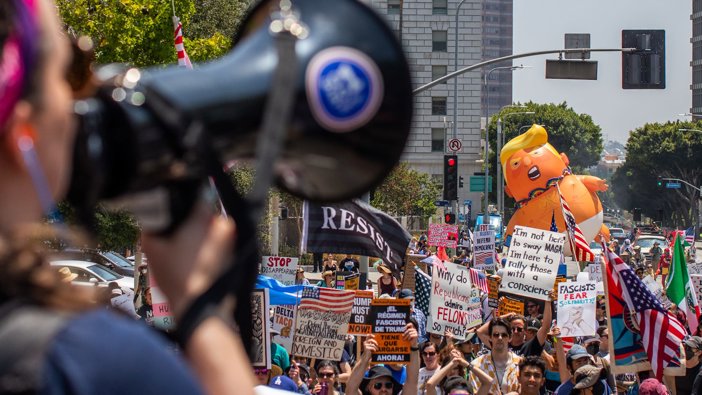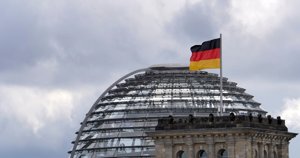
‘No Kings’ Protests Sweep U.S. Against Trump’s Powers
Millions of Americans took to the streets under the banner “No Kings,” voicing alarm at what they see as authoritarian drift in the Trump administration.
On Saturday, October 18, 2025, a wave of protests swept across every state in the U.S., as part of the nationwide “No Kings” movement, aimed at President Donald Trump and what protesters describe as a growing drift toward autocratic rule. Sources estimate more than 6 million participants gathered in over 2,600 locations, making it one of the largest single-day protest events in U.S. history.
A Colorful, Defiant Street Message
In Manhattan’s Times Square, marchers led by brass horns, drums and rattles wound southwards through Midtown, the mood both festive and unmistakably serious. Homemade signs depicted Trump with a Hitler-style mustache or as a baby cradled by Russian President Vladimir Putin. One prominent banner declared simply: “No Kings.” Organizers say the slogan arises from their conviction that the president is acting like a monarch, not a representative of the people.
Among the attendees, Catherine—a longtime activist—stood with a placard reading “For my grandchildren.” “I’ll be gone before they live with the result of this shift,” she said. “But I must stand now.” Her words tracked across many narratives: participation grounded in generational concern and democratic fear.
Even as cities held large rallies, even small towns joined the movement. In Manistee County, Michigan, nearly 1,000 participants marched along U.S. Highway 31, forming a human “No Kings” sign and emphasizing peaceful civil rights activism.
Scope and Scale: Historic, Yet Purposeful
The numbers are staggering. In New York City alone, police estimated over 100,000 people took part with virtually no arrests. Similar numbers were reported in Los Angeles, Chicago, Atlanta and Washington, D.C., while countless smaller marches occurred in rural or suburban regions. That breadth conveys a message: this is not a fringe movement—it is a nationwide surge with a unifying theme.
What made the protests remarkable, analysts say, is their hybrid nature: part street party, part political declaration. Armed with costumes, horns and rally signs, participants combined theatricality with determined critique. The event also included notable appearances: in Washington, Senator Bernie Sanders addressed a crowd that received him nearly like a rock star, declaring “we, the people, will govern” rather than being ruled by a king.
Core Grievances: Power, Policy & Democracy
The protests centered on several interconnected concerns:
- Concentration of power: Protesters voiced fear that the president was bypassing democratic checks, aligning with militarised operations in domestic settings and treating opposition cities with force.
- Immigration enforcement and civil rights: Chants of “Yes to our people, yes to migrants” countered the administration’s aggressive immigration tactics and National Guard deployments in opposition-governed cities.
- Symbolism and narrative: By branding their movement “No Kings,” organizers referenced both historical monarchical rule and modern autocratic risk—suggesting the U.S. may be drifting from its founding “We the People” governance model.
Critics within the Republican ranks dismissed the movement as un-American or radical. House Speaker Mike Johnson and others characterized the protestors as harboring “hate America” sentiments. Protest leaders countered: “We love our country—we hate what our government is doing.”
Government Response: Dismissal and Disputation
President Trump spent the day of protest at his Mar-a-Lago estate in Florida. In a Fox Business interview, he stated: “They call me a king. I’m not a king.” Hours later, he released an AI-generated video depicting himself as a crowned fighter pilot dropping brown liquid on protesters—an action critics say underscored the protest’s very accusations.
Law enforcement response was largely non-confrontational at the marches. Across major cities, police reported minimal incidents and high levels of coordination. That said, the presence of National Guard and federal forces in certain jurisdictions signals how seriously authorities treat potential unrest.
Why Now? Strategic Timing and Political Context
This large-scale mobilization did not arise spontaneously—it built on earlier iterations and deep structural trends. The protest “No Kings Day” movement previously held similar nationwide rallies in June 2025, with estimates of over 5 million participants across 2,100 locations.
Moreover, the timing corresponds with a broader pattern of democratic anxiety: prolonged government shutdowns, aggressive executive action, military deployments in domestic contexts and cultural polarisation. The protest offered visible evidence of escalating discontent.
For the opposition, the movement represents a chance to reframe political debate away from discrete policy items and toward governance itself—asking not just what is done, but how and who wields power.
What exactly does “No Kings” mean?
It encapsulates protesters’ assertion that the president is acting like a monarch—with limited accountability—and that democratic structures are being undermined.
Are these protests focused only on Trump’s presidency?
While Trump is the immediate target, the movement taps deeper fears: increasing executive dominance, weakened institutional checks and rising deployment of force in civil contexts.
Will this impact upcoming elections?
Possibly. The scale and visibility of the movement may energize formerly disengaged voters and shift the framing in battleground regions from policy to democratic identity and governance norms.
Could the movement backfire by triggering backlash?
Yes—the alignment of protests with opposition parties and framing as un-American by critics risks alienating moderate voters. The movement’s long-term effect depends on inclusive messaging and sustained organisation.
Strategic Implications for U.S. Politics
The “No Kings” movement represents more than an event—it signals a turning point in how Americans engage with democracy. For the White House, it poses reputational risks and draws attention to governance style rather than specific legislation. For civic organisations and the opposition, it offers a rallying infrastructure rooted in values, not just ideology.
In battleground states and key congressional districts, the movement’s footprint may shift electoral dynamics. Candidates may need to address not only what policies they support, but how they support democratic norms, minority rights and fair governance.
If the movement continues and evolves beyond a single day, it could shape 2026-2028 elections and change how protests convert into policy demands and electoral outcomes.
Conclusion: A Statement Rather Than a Riot
On one Saturday in October, millions of Americans marched not simply in anger—but in reflection of a deeper anxiety: about power, privilege and democracy itself. While the celebrations, horns and signs made it visually memorable, the message lingered: leadership must belong to the people.
Whether this becomes a sustained movement or dissolves into one-day spectacle remains unclear. For now, the streets spoke—and politics listened.
Source: Time Reuters Associated Press Wikipedia AP News






